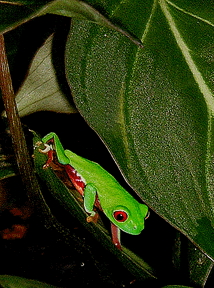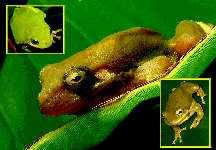![]()
Aroids and other genera in the Collection
Take the Tour Now?
Orchids
The
Exotic Rainforest
The Sounds
and the Animals
of our Rainforest
Tree Frogs, Anoles and Crickets
of our Rainforest
Tree Frogs, Anoles and Crickets
The rain forest has many sounds. The sound of water falling over stones. Rain. Crickets chirping, and the beautiful calls, chirps and "cribbits" of tree frogs.
Well, some have beautiful calls. The Red Eyed Costa Rican tree frog (Agylychnis callidryas) is one with a beautiful "chirp" while the Barking tree frog (Hyla gratiosa) is not quite so glorious. Instead, it is at least a sound with interest!
 During the
mating season the adult Red Eye often spends the nights
calling for a mate while the Barking tree frog (upper left) just barks like a miniature puppy both during the day and in the
evening. Visitors to our Exotic Rainforest are almost always caught off
guard when they first hear the "bark" of a frog. Especially if one is
hidden on a tree branch or plant just a few feet away.
During the
mating season the adult Red Eye often spends the nights
calling for a mate while the Barking tree frog (upper left) just barks like a miniature puppy both during the day and in the
evening. Visitors to our Exotic Rainforest are almost always caught off
guard when they first hear the "bark" of a frog. Especially if one is
hidden on a tree branch or plant just a few feet away. The barking tree frog is a beautiful light green while the Costa Rican Red Eyed frog has not only the beauty of the greens since as a juvenile it has red markings on it's chest as well as those brilliant red eyes! The "red-eye" in the upper right inset is a juvenile just over 1 inch long. The red on the belly subsides as the frog matures and changes to a pale to medium blue The adult Red Eye is approximately 2 1/2 inches. All of our Costa Rican Red Eyes were introduced to the atrium as juveniles and are just now maturing. A number of our tree frogs are the common Green Tree Frog (Hyla cineria) shown at the middle right. These attractive frogs have a white band on their side and are about 3 inches. The adult Barking tree frog is approximately 3 inches.
 My
adult daughters
thought I was more than a bit strange when I began to request "tree frogs"
when asked what I wanted for birthday presents and Father's Day. They
finally gave in and we now have at least 30 living in the fronds and branches of
our atrium.
My
adult daughters
thought I was more than a bit strange when I began to request "tree frogs"
when asked what I wanted for birthday presents and Father's Day. They
finally gave in and we now have at least 30 living in the fronds and branches of
our atrium.
Crickets? Yes, we have lots of crickets. The frogs and
anoles (Anoles carolinenisis), small green lizards, (inset lower
right) require a source of live food so we approximately 1000 baby
crickets monthly to feed everyone. But the crickets do have a side
benefit. It wouldn't be a rainforest without the sounds of the crickets
in the evening.
During the spring several of the frog species produce tadpoles in the pond!
During the spring several of the frog species produce tadpoles in the pond!

The photo will lead you to the baby frogs